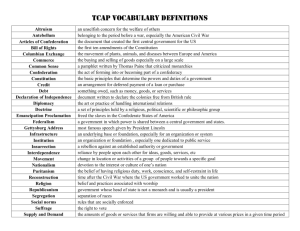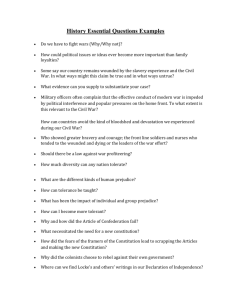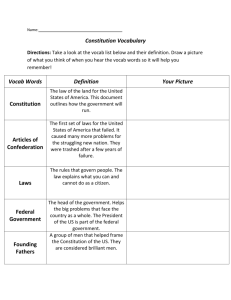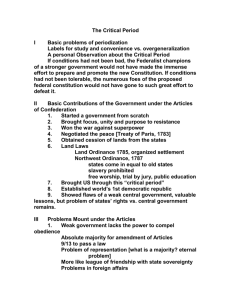Articles of Confederation
advertisement
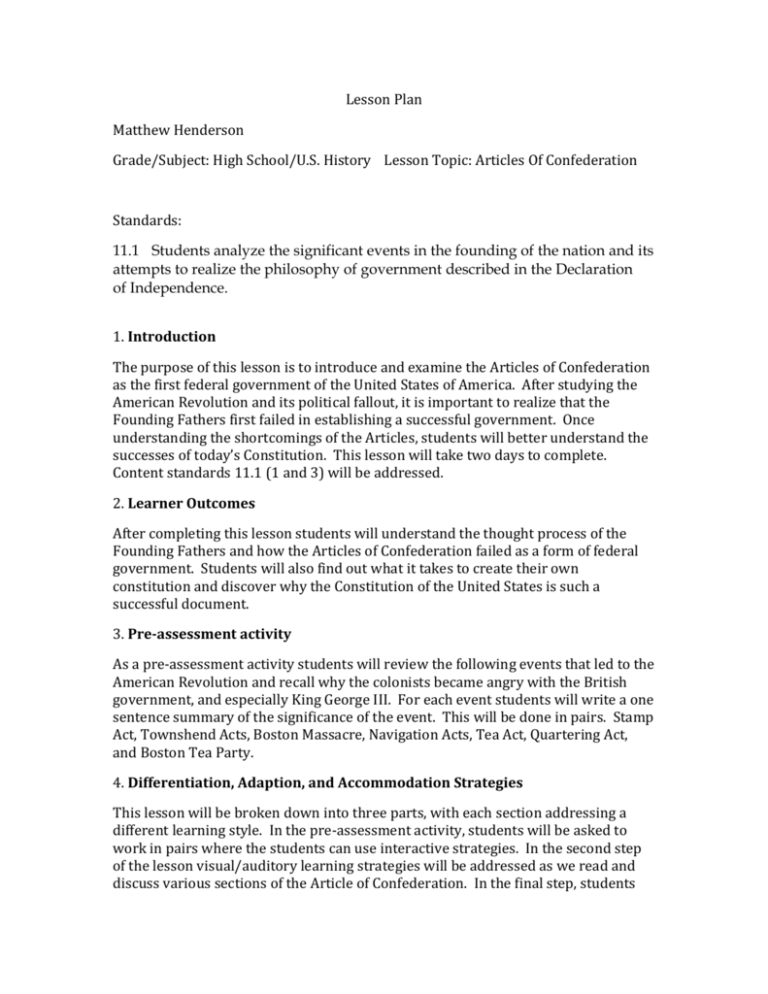
Lesson Plan Matthew Henderson Grade/Subject: High School/U.S. History Lesson Topic: Articles Of Confederation Standards: 11.1 Students analyze the significant events in the founding of the nation and its attempts to realize the philosophy of government described in the Declaration of Independence. 1. Introduction The purpose of this lesson is to introduce and examine the Articles of Confederation as the first federal government of the United States of America. After studying the American Revolution and its political fallout, it is important to realize that the Founding Fathers first failed in establishing a successful government. Once understanding the shortcomings of the Articles, students will better understand the successes of today’s Constitution. This lesson will take two days to complete. Content standards 11.1 (1 and 3) will be addressed. 2. Learner Outcomes After completing this lesson students will understand the thought process of the Founding Fathers and how the Articles of Confederation failed as a form of federal government. Students will also find out what it takes to create their own constitution and discover why the Constitution of the United States is such a successful document. 3. Pre-assessment activity As a pre-assessment activity students will review the following events that led to the American Revolution and recall why the colonists became angry with the British government, and especially King George III. For each event students will write a one sentence summary of the significance of the event. This will be done in pairs. Stamp Act, Townshend Acts, Boston Massacre, Navigation Acts, Tea Act, Quartering Act, and Boston Tea Party. 4. Differentiation, Adaption, and Accommodation Strategies This lesson will be broken down into three parts, with each section addressing a different learning style. In the pre-assessment activity, students will be asked to work in pairs where the students can use interactive strategies. In the second step of the lesson visual/auditory learning strategies will be addressed as we read and discuss various sections of the Article of Confederation. In the final step, students will be asked to create a rough draft of a constitution in small groups, thus using interpersonal and kinesthetic strategies and methods. Students will also be provided with handouts to help support their learning. Time permitting, we will also view a picture of the Constitutional Convention of 1787 on the LCD projector, thus incorporating technology as well. 5. Resources Students will need handouts, paper, pens/pencils, computer, LCD projector 6. Learning Activities After the pre-assessment activity, which will take 10 minutes, I will handout copies of 6 articles from the Articles of Confederation. I will have students follow along as I read them out loud, then, as a class, we will translate them into more comprehendible language. At this point class discussion will also be held as I ask the class questions regarding each individual article. This portion of the lesson will take 30 minutes. The third, and final, portion of the lesson will require students writing a rough draft of a constitution in small groups. This constitution will be revised and combined with other groups’ constitutions in order to make one class constitution that will be ratified unanimously. 7. Learning Activities, Guided Practice/Collaborative Practice: While students work, I will walk around the class and provide positive verbal feedback. With such a small class, I will be available to help the students on a one on one basis as I circle class. I will also be able to check for understanding through questioning. Students will also be allowed to collaborate with each other during the pre-assessment and constitutional writing portions of the lessons. 8. Independent Practice As homework, students will be asked to write two strengths and two weaknesses of the Articles of Confederation. This will give students the opportunity to review material on their own while forming their conclusions regarding the historical document. This assignment will be collected the following day. 9. Assessment Evaluation The assessment for this material will after the Constitution of the United States has been covered. Students will then be asked to create a Venn Diagram that shows where the Articles of Confederation and Constitution differed, where they had similar ideas, and what was unique to each. 10. Closure In order to obtain closure on the Articles of Confederation, we will study the Constitution of the United States immediately after this lesson. After comparing and contrasting the two documents the Socratic method of questioning will be used to lead students to understand the necessity of the new government and the ideas behind the Founding Fathers. It will also show the holes in the articles and the success of collaboration and revision. 11. Lesson Reflection/Assessment In addition to the Venn diagram and class discussion, students will have the opportunity to show what they have learned during the chapter test. In the form of a short answer question, students will be asked to determine the weaknesses of the Articles of Confederation and explain why they failed. In addition, students will be asked to discuss the strengths of the Constitution and explain why it has persevered over the past 222 years. These questions will be graded as part of the chapter exam given at the conclusion of Chapter 5.
